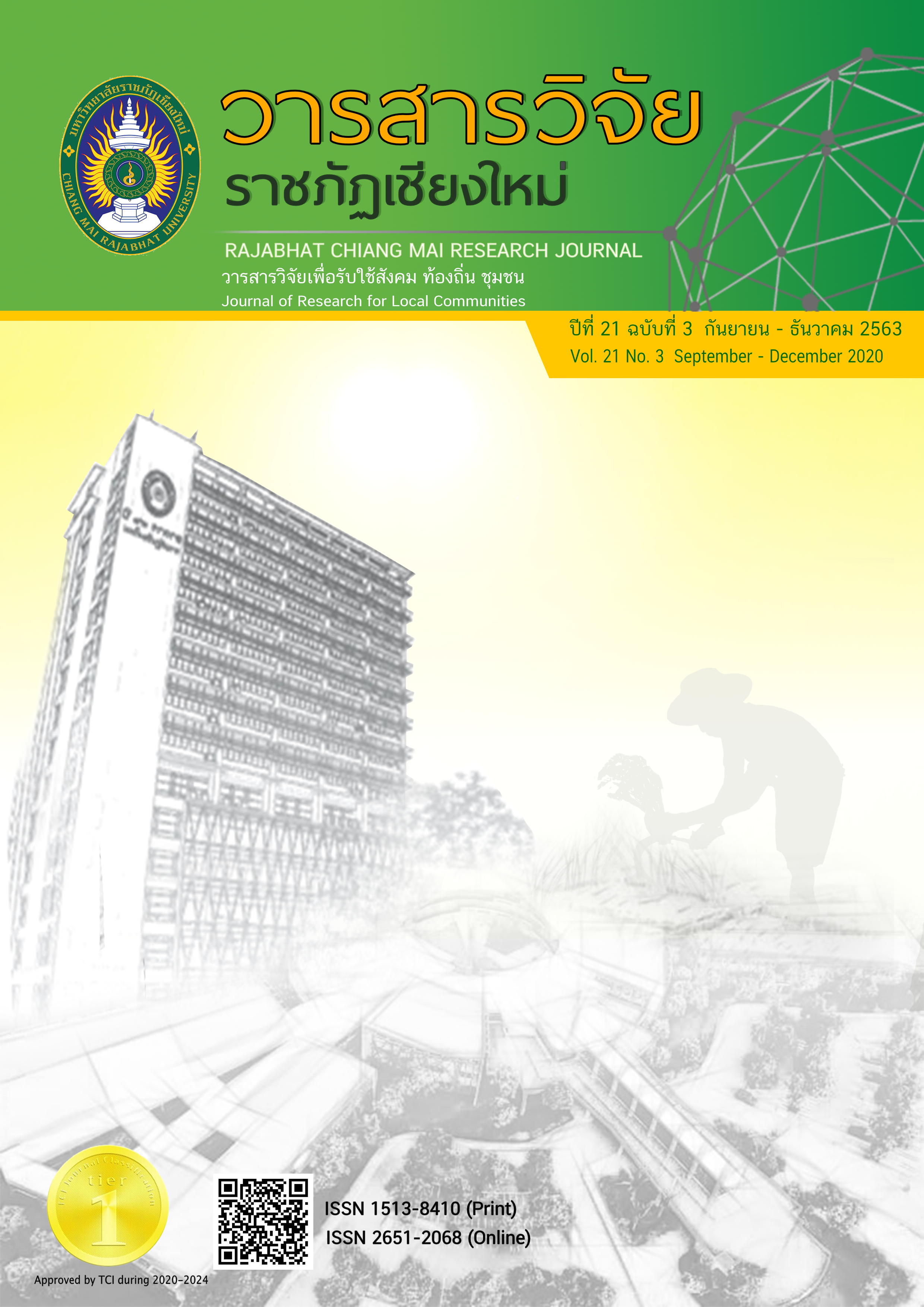The Influence of Service Marketing Mix and the Perception of Corporate Image Affects the Loyalty of Customers of Resort and Homestay in Phetchaburi Province
DOI:
https://doi.org/10.14456/rcmrj.2020.238389Keywords:
Service marketing mix, Corporate image, Loyalty of customersAbstract
This study was aimed at 1) Study the influence of service marketing mix, perception of corporate image and loyalty of customers; 2) Study the influence of service marketing mix that affects loyalty of customers and 3) Study the influence of service marketing mix and the perception of the corporate image that affects loyalty of customers of resort and homestay in phetchaburi province. The research samples were 400 customers selected by using simple random sampling. The research instrument was a questionnaire. The data were analyzed by using frequency, percentage, mean, standard deviation and multiple regression analysis. The research results were as follows: 1) Service marketing mix, the perception of the corporate image and loyalty of customers was totally a high level. 2) Influence of service marketing mix including place, price, promotion and process has a positive effect on loyalty of customers with the level of .01 statistically significance. All of them could predict efficiency of 65.50 percent. and 3) Influence of service marketing mix and corporate image has a positive effect on loyalty of customers with the level of .01 statistically significance. All of them could predict efficiency of 71.20 percent
From this research, it was found that the service marketing mix strategy is important for the resort and homestay, which must be development to be of quality to meet the needs and satisfaction of customers. And creating a good image of the business to achieve customer loyalty resulting in frequent re-se of the service.
Downloads
References
Economic Research Center Business and the foundation economy savings bank. (2018). Industry situation Travel 2018 - 2019. Retrieved from https://www.gsb.or.th/getatt . achment/75c08f31-a88f-4518-bd59-20b073e9ad43/6_travel_12_61_detail.aspx (In Thai)
Chaiyagul, C. (2012). Corporate Image, Brand Equity and Customer Satisfaction in Service Marketing Mix as Influences of Loyalty Levels: Thailand Post CO., LTD. Customers. (Master of Business Administration, Major Field: Business Administration, Faculty of Business Administration, Kasetsart University). (In Thai)
Chokratsamesiri, N. (2015). Marketing Mix Factors Relating to the Loyalty of Consumers for Budget Hotel in Muang District Nakhon Phathom Province. (Master of Business Administration, Major Field: Business Administration, Graduate School, Silpakorn University). (In Thai)
Dararuang, K., Kao-un, S., & Chongketkorn, C. (2018). Perceived Service Quality and the Marketing Mix Affecting the Hotels Customers’ Loyalty, Muang District. Nakhonsawan Province, 12(special), 57-70. (In Thai)
Department of Business Development. (2018). Hotel, resort and condominium business. Retrieved from https://www.dbd.go.th/download/document_file/Statisic/2561/T26/T26_201808.pdf (In Thai)
Dumlak, k., Plangcharoensri, K., Sriprachan, W., & Phangniran, B. (2015). Antecedents Affecting on Tourists’ destination loyalty of Phuket Province. Journal of the Association of Researchers, 20(2), 81-93. (In Thai)
Hosseini, R. S., Zainal, A., & Sumarjan, N. (2015). The Effects of Service Performance of Hotel Customers on Quality of Experience and Brand Loyalty in Iran. Procedia-Social and Behavioral Science, 201, 156 – 164. https://doi.org/10.1016/j.sbspro.2015.08.163
Jacoby, J., & Chestnut, R. (1978). Brand Loyalty: Measurement and Management. NewYork: John Wiley and Sons.
Kanchanawasi, S., Pitayanon, T., & Srisuko, D. (2008). Proper Research Statistic Selection. (5th ed.). Bangkok: Chulalongkorn University Printing. (In Thai)
Kerlinger, F. N., & Pedhazur, E. J. (1973). Multiple regression in behavioral research. New York: Holt, Rinehart and Winston.
Kim, Y. E., & Lee, J. W. (2010). Relationship Between Corporate Image and Customer Loyalty in Mobile Communications Service Markets. Africa Journal of Business Management, 4(18), 4035 – 4041.
Kotler, P. (2000). Marketing Management. (10th ed.). New Jersey: Prentice-Hall Inc.
Kotler, P. (2005). Marketing Management. (12th ed.). New Jersey: Prentice Hall.
Kotler, P., & Armstrong, G. (2014). Principle of Marketing. (15th ed.). USA: Pearson Education.
Kotler, P., & Keller, K. (2016). Marketing Management. (15th ed.). NewJersey: Pearson Education.
Lomax, R. G., & Hahs, D. L. (1992). Statistical Concepts: A Second Course. UK: Routledge.
Mongkolsiri, S. (2004). Brand Management. Bangkok: Higher Press Co-Publishing Brand Age. (In Thai)
Pong, L. T., & Yee, T. P. (2001). An integrated model of service loyalty. In International Conferences Brussels. Belgium.
Rittham, A. (2015). Relationships between Organizational Reliability and Customer Loyalty of Hotel Business in Thailand. (Master of Economic, Major Field: Business Economics, Faculty of Accounting and Management, Mahasarakham University). (In Thai)
Srisaard, B. (2013). Fundamental research. (7th ed.). Bangkok: Chomromdek. (In Thai)
Takoonmukthong, A. (2016). Service Marketing Mix Strategies Influencing Perceptions of Service Quality and Loyalty of Foreign Tourists in Thailand Health Tourism Business. RMUTT Global Business and Economics Review, 11 (2), 115-128. (In Thai)
Thoatrakol, N. (2018). The influence of Brand image and Value toward Organizational Performance in Budget hotel in Mueang District, Chiang Mai. MUT Journal of Business Administration, 15(2), 1-20. (in Thai)
Zeithaml, V. A., Berry, L. L., & Parasuraman, A. (1996). The behavioral consequences of service quality. Journal of Marketing, 60(2), 31-46. https://doi.org/10.1177/002224299606000203
Downloads
Published
How to Cite
Issue
Section
License
1. Articles, information, content, images, etc published in the “Community and Social Development Journal” are copyrighted by the Community and Social Development Journal, Chiang Mai Rajabhat University. In order to properly distribute the articles through print and electronic media, the authors still hold the copyright for the published articles under the Creative Commons Attribution (CC BY) license, which allows the re-distribution of the articles in other sources. References must be made to the articles in the journal. The authors are responsible for requesting permission to reproduce copyrighted content from other sources.
2. The content of the articles appearing in the journal is the direct responsibility of the article authors. The editorial board of the journal does not necessarily agree with or share any responsibility.














